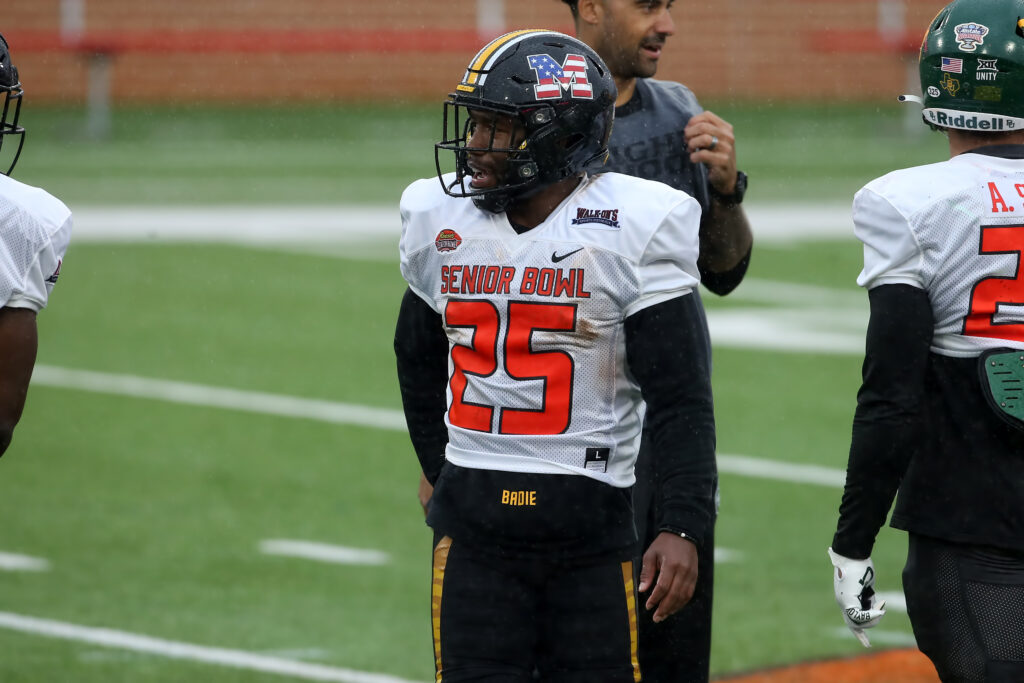This article is part of a series in which I evaluate 2022 rookie running backs solely on their ability to run the ball. The first installments can be found here. If you happened to already catch those and don’t need a refresher on my methodology, feel free to skip to the player-focused analysis below the picture of Missouri’s Tyler Badie a couple paragraphs down.

Outside the ability of whoever happens to be running the ball, there is a whole mess of variables that factor into the effectiveness of a given rushing attack: scheme, play-calling tendencies, opponent strength and scheme, weather, offensive line play, surrounding skill-position talent, etc. And given this entanglement, separating the contributions of the ball carrier from the offensive environment in which he operates is not a straightforward task. My approach to doing that is centered around measuring the degree to which a running back is over- or under-performing the per-carry output of the other running backs on his team.
Starting from the premise that good runners do more with what they are given than do bad runners, it stands to reason that, provided players are operating under generally the same conditions (like, for example, playing on the same team), better backs should produce more per carry than lesser backs. Using this logic, we can establish a baseline for comparing efficiency between players on the same team; for each running back, we can compare his performance (X) to the collective performance of every other running back on the team (Y). If X > Y (essentially, if dude is doing more with his carries than his teammates are with theirs), we can probably conclude that the player in question is a good player, at least to some relative degree.
Assuming that this is a sound method of evaluating running backs relative to their teammates, we can then extend our comparisons to players from other teams (we’re really just creating a baseline for efficiency comparisons similar to how Dominator Rating and other market share-based metrics create baselines for volume-based comparisons).
The key metrics I use to evaluate running back performance vs. that of their teammates are called Yards Per Carry+, Chunk Rate+, and a metric I developed recently called Box-Adjusted Efficiency Rating, or BAE. I also like to use a metric called Breakaway Conversion Rate, but that is not a teammate-relative measure and we’ll therefore look into it separately.
The metrics are pretty straightforward: YPC+ is the degree to which a player over- or under-performs his teammates in yards per carry, and Chunk Rate+ is the degree to which a player over- or under-performs his teammates in rate of “chunk” runs (which I classify as runs of 10 yards or more). At a basic level, I want my running back prospects to find a way to produce more per carry than the other backs on the team, and part of that puzzle is navigating the line of scrimmage and extending runs into the secondary at a higher rate than his backfield mates. YPC+ and Chunk Rate+ measure the degree to which a player does both of these things.
BAE also does those things, but it improves upon Yards Per Carry+ by using a weighted average of a player’s per carry efficiency on carries vs. various amounts of defenders in the box (using data from Sports Info Solutions), relative to the per carry efficiency of other running backs on his team vs. the same box counts. The resulting percentage indicates to what degree a runner over- or under-performed his teammates on his total rushing attempts, relative to how often he faced each box count. BAE is a more comprehensive metric than is YPC+, and I will defer to it accordingly, but YPC+ and Chunk Rate+ will still be used given that the sample of data I have for those metrics goes back a decade-plus (while I’m only able to generate BAE Ratings going back to the 2018 college football season).
THE METRICS

Missouri’s Tyler Badie — along with Kyren Williams and Tyler Goodson — is another one of these undersized lead-back types available in 2022 rookie drafts, and Badie was actually the most dominant college producer and most prolific receiver of the three of them. Let’s see how his rushing efficiency profile stacks up to the 44.6-percent Dominator Rating (in the 91st-percentile among backs drafted since 2007) and the 18.2-percent Target Share (96th-percentile) he posted as a senior this last season:
While Missouri is an SEC program, they’re not an especially good one. The teams that Badie was a member of were consistently pretty weak following an 8-5 campaign in his freshman season (that would be the Drew Lock, Albert Okwuegbunam squad), and the guys that he shared a backfield with during this time were not an especially talented group either. Collectively, they averaged just a 2.84-star rating as high school recruits, making them a 31st-percentile set of runners.
Badie outperformed that running back room by 0.23 yards per carry over his career, a 38th-percentile mark. He was actually more consistent than those guys were at navigating the first levels of the defense and reaching the secondary, as his career Chunk Rate+ is a positive 2.72-percent, good for the 67th-percentile. It would seem then, that his underwhelming YPC+ mark is a product of his failure to create big plays once he got to that second level, reflected by his 25.4-percent Breakaway Conversion Rate, a 27th-percentile performance in the open field.
Badie was also more efficient than his teammates when accounting for the amount of defenders in the box they each saw on their respective carry loads. But like his raw YPC+ showing, his 108-percent BAE Rating is not impressive relative to other pro prospects at the position, as it lands in just the 26th-percentile. Given his receiving prowess and his small stature — he caught more balls per game than 94-percent of historical running back prospects, weighed 199-pounds and measured just shy of 5-8 at the Senior Bowl — it should come as no surprise that the 0.30 fewer average defenders in the box he saw make for the lightest team-relative box count of any back I have box count data for. Considering that defenses were rolling out the red carpet for him to run the ball combined with the fact that his backfield teammates were not an especially talented group, the degree to which his efficiency outpaced theirs is simply not up to par in the context of historical prospects.
RUSHING EFFICIENCY SCORE AND COMPS
This fact is reflected by Tyler Badie‘s mark in my running back model’s Rushing Efficiency Score, a composite that accounts for the all of the non-BAE metrics we’ve gone over so far, in addition to offensive line play, overall team quality, strength of opponent, and rushing volume. The 47.9 out of 100 that Badie earns is a mediocre number. The 27.8 that he earns in a prototype BAE-centric composite that I’m workshopping is even worse, and would pin his team-relative rushing efficiency profile as one of the five worst in the class.
Based on the same metrics that make up the Rushing Efficiency composite in addition to physical measurables, my model also generates similarity scores between players. If we assume that he runs a 4.48 (lol idk), here are the guys whose “pure runner” profiles comp most cleanly to his:

Barf. Unless you count Tony Pollard and his dynasty bro sex appeal (he’s also 10 pounds heavier), none of these guys are any good. Like them, Badie is simply not going to earn an NFL role on his merits as a ballcarrier.
LAST WORD
How Tyler Badie could earn an NFL role is on his merits as a pass-catcher, and he does boast one of the best receiving profiles of any back in this class. Reports out of the Senior Bowl were also positive, which theoretically means something, so perhaps NFL front offices like him. I’m skeptical, however, that they *like* like him, because to me he looks like a fairly run-of-the-mill satellite back-type who had a productive senior season at a blah program after backing up Larry Rountree and Damarea Crockett for three years. You can do better in rookie drafts.


